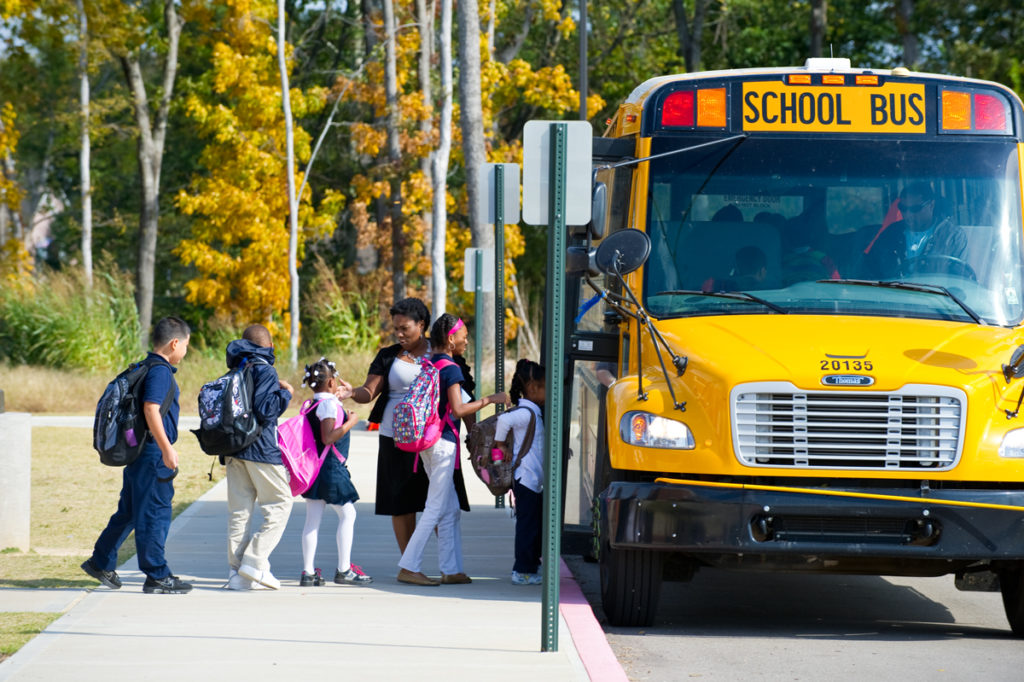
 Teachers Help Build Bus Communities
Teachers Help Build Bus CommunitiesAt Grafton, all 707 students are assigned to a bus. “That means fifteen buses with all the usual problems, including bullying,” says fifth grade teacher Martha Hanley. Recognizing that children’s experiences on the bus were affecting their ability to learn in school, she and seven other teachers set out to make time on the school bus safer and more pleasant for children and drivers. Building on Responsive Classroom practices already in use in Grafton’s classrooms, last year these “bus teachers” designed and piloted a program that helped the children significantly improve their bus behavior.
Inspired by reading about other schools’ solutions to bus behavior problems in Creating a Safe and Friendly School, the eight teachers volunteered as “bus teachers.” Each would be responsible for one or two busses. They’d begin their improvement effort by helping the students on each bus create their own rules.
Each bus teacher arranged a twenty-minute meeting early in the school year for her bus riders. At these meetings the children, who were from all three grades (third through fifth), got to know each other, shared ideas about what good days on the bus were like, and produced a short, general list of rules that, if followed, would result in more good bus days.
For the rule making, the bus teachers adapted the approach Grafton uses to create classroom rules with students. Involving students in rule creation, the school has found, helps them feel more invested in behaving according to those rules. Importantly, the rules toward which the teachers guided the students consisted of statements emphasizing what children should do, such as “Be respectful to yourself and others” and “Be safe,” rather than a long list of No’s, such as “No hitting” or “No standing in the aisle.”
“Having rules for their bus in their own words made those rules more meaningful,” says Martha, “and even though each bus ended up with slightly different rules, they all covered similar ideas about being safe, respectful, and kind to others.”
Because the children were also still expected to follow the “Bus Riders’ Code of Conduct” in the student/parent handbook, the bus teachers helped them understand that the code’s requirements, such as “Sit down when the bus is moving,” fit with the children’s own rules about being safe and respectful.
Next came a talk with the bus drivers. The teachers described the pilot program and presented the drivers with the children’s rules. They also explained that they would now be the first to receive drivers’ reports about behavior issues on the bus. The bus teachers would address minor problems themselves; the office would be involved for more serious incidents. This new system encouraged the drivers to report minor problems early, without worrying about getting the children “in trouble.”
When the bus teachers got word of trouble on the bus, they met with students individually, in small groups, or as an entire bus group. They guided the students in applying the same problem solving strategies they used in other areas of the school to addressing and preventing bus problems.
At mid-year, each bus teacher and her group revisited the rules they’d created together. Some groups made adjustments; for all groups, the mid-year meeting helped keep the rules meaningful and fresh.
Throughout the year, the bus teachers checked in with the children and the drivers from time to time just to see how things were going. Students let their bus teacher know of any problems by putting a note in her mailbox or speaking with her during the school’s daily ten-minute morning break.
Reflecting upon their pilot year, the bus teachers agreed that the children’s bus behavior had clearly improved. Incident reports had dropped, problems were resolved more quickly, and the children’s ability to concentrate in their classrooms had improved. The program, they agreed, should continue—but they’d need to find a way to make “bus teaching” less time consuming.
So, with support from administrators and staff who’d been convinced by the first year’s successes, the core group adapted the program so that about sixty of the school’s teachers and specialists would become “bus teachers.” Teams of three or more teachers would hold bus group meetings several times a year. To simplify preparation, the eight original bus teachers would provide meeting outlines, and a “go to” team (Martha, two other teachers, and the assistant principal) would provide problem solving support to the other bus teachers.
Bus teachers have helped the whole school stay focused on the common goal of “more good days on the bus for everyone.” Their work sends a clear message: The Grafton community is committed to making the school a safe and caring place, and time spent on the bus is part of being at school. “With this approach, we’re headed in the right direction,” says Martha.
Setting: Suburban
Grades: 3–5
Number of students: 707
Number of classrooms: 32
% of students receiving free or reduced-price lunch: 10%